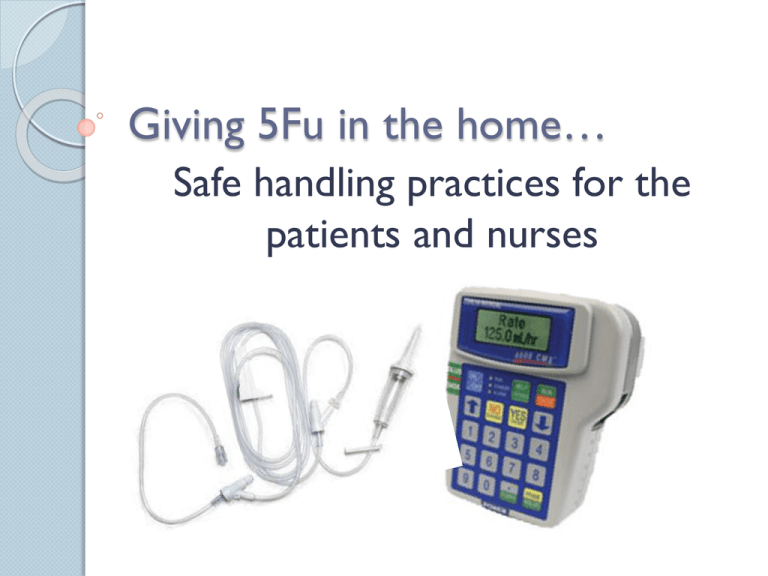
Giving 5Fu in the home…
Safe handling practices for the
patients and nurses
What is 5FU?
5FU or 5-Fluorouracil is a chemotherapy drug that
is cell cycle specific. Cell cycle specific means that
the 5FU attacks cancer cells at a specific phase in
cell division.
Cell cycle non specific means that the chemo will
work no matter where the cell is in it’s cell division
process.
Most of our patients are getting a combination
treatment most commonly called FOLFOX.
What is 5FU?
FOLFOX is a combination of:
Oxaliplatin (non cell cycle specific),
•Leucovorin-(cell cycle specific)
•5FU (cell cycle specific)
Oxaliplatin is non cell cycle specific which means
will kill cancer cells any time in a cells growth.
Patients will receive Oxaliplatin, Leucovorin
infusions with a 5FU push in clinic and then a
connection to a 46 hour infusion of 5FU.
How do we give 5FU?
We administer 5Fu either by an Intermate
device or by Curlin pumps.
Most infusions go at a slow rate 2 to 10 mls. per
hour over 46 hours on FOLOX regimen. Some
patients receive a combination therapy that
includes radiation Monday through Friday and
continuous 5FU administered Monday through
Friday for a 6 week course.
The radiation patients would then have a once a
week bag change and line care (either PORT or
PICC care) in the treatment room with their bag
change.
What do 5Fu patients get from
DHCH to manage 5Fu in home?
•Chemo spill kit
•Chemo Container
•Instructions for chemo in the home
•These items help us teach the patient/caregiver how to
dispose of chemo, how to flush line for emergent
reasons, how to clean a spill and who to call if this
happens.
5Fu or 5-Flurouracil
A course of 5Fu treatment is given to patients for the
treatment of GI cancers, such as colon/rectal, anal,
esophageal, pancreatic, gastric and also some breast
cancers. At DHCH, we see mostly GI cancers on 5FU.
The typical course consists of IV therapy every 2 weeks
for a total of 12 cycles.
Some patients may have chemotherapy pre-surgery for
tumor reduction, then surgery for removal of tumor,
then another course of chemotherapy post surgery to
treat any remaining cancer. Some patients may not need
surgery at all and still others may need radiation to
shrink tumors. It’s all dependent on size, stage and type
of cancer. 5FU treatment for GI cancer is what we
typically see in the home.
5Fu or 5-Flurouracil
The typical day of a 5FU patient starts with a PORT
access, some patients may have a PICC line for chemo
which they will keep for the duration of treatment.
Then they go for a lab draw, current weight and
calculation of the BSA.
They may or may not see the doctor. Then, based on
labs, they may then get an infusion in clinic that could
take up to 3-4hr to complete, then subsequent hook up
by one of our infusion nurses to the 5FU, and then
home. The patient will be hooked up to a continuous
infusion of 5FU for the next 46 hours. Then after 46
hours the patient will need to be disconnected, flushed
and de-accessed in the home (otherwise know as a
“takedown”). That’s our part.
Priming a tubing with 5Fu
In order to prime a tubing with IV
fluid which contains 5Fu:
1. Put on blue gloves
2. Obtain a piece of gauze
3. Hold the tubing over a chemo
container
4. Prime the tubing into the small
piece of gauze
5. Dispose of gauze into the container
What are the side effects of 5FU?
Things to remember about 5FU….
•Side effects are often predictable in onset and duration
•Side effects are often reversible and will go away after
treatment is complete
•Side effects depend on variety of factors including
Dosage
Metabolism
Other drugs given as part of combination therapy
Schedule and duration of treatment
What are the side effects of 5FU?
Side effects that are most common in 5FU
patients (occurring greater than 30% of
patients)
•Diarrhea
•Fatigue
•Nausea and occasional vomiting
•Metallic taste in mouth
•Mouth Sores
•Poor appetite
What are the side effects of 5FU?
Low blood counts including red, white and platelets
which causes increased risk for infection, anemia and
bleeding.
•This occurs at the “nadir”, and is the mid-point
between chemo cycles where blood counts are the
lowest
•Onset 7 to 10 days
•Nadir 9 to 14 days
•Recovery 21 to 28 days
What are the side effects of 5FU?
Side effects that are less common in 5FU patients
(occurring in 10 to 29 %)
•Skin changes dry cracked peeling skin darkening of skin
•Hair thinning
•Hand-Foot syndrome reddened skin peeling skin pain
palms of hands soles of feet usually after 5 to 6 weeks of
treatment will decrease dose as needed
Hand Foot Syndrome
What are the side effects of 5FU?
Fever
If patient is febrile greater 100.5* chills, sweats
CALL MD ASAP!!
How to help patient’s manage side
effects?
•Salt water rinses to PREVENT mucositis
•Drink plenty of fluids
•Anti diarrheal meds
•Eat a bland diet, with low fiber foods, including bananas,
rice, and noodles. And encourage low fat foods and small
portions spread out over the day
•Avoid crowds and people with colds
•Wash hands often
•Use anti-nausea meds as prescribed
•Get plenty of rest
•Wear sunscreen SPF 15
•For mouth sores rinse mouth with 1 to ½ tsp of salt in 8 oz
of water 3 to four times per day
What are things we should
document?
•Medication given
•Dose
•Route
•Rate
•Side effects
•Type of device
•What did you educate your
patient/caregiver about?
•Patient response to
medication and teaching
•What cycle of Chemotherapy
•Medication given
•Dose
•Route
•Rate
•Side effects
•Type of device
•What did you educate your patient/caregiver
about?
•Patient response to medication and teaching
•What cycle of Chemotherapy
What do we teach our patients and
caregivers?
•How to flush line if needed
•Use of special “blue”, nitril gloves
•How to dispose of chemotherapy supplies
including all tubing and medication bag into a
large yellow chemo container
•We review the chemo spill kit and demonstrate its
use
•If spill on skin, wash area well with soap and water
assess for rash
•If spill on bed linens or clothes, wash in washer
x2, use spill kit
How do you transport, store and
dispose of chemotherapy?
•Store in leak proof container, large yellow
containers
•When priming chemo line, prime into chemo
container
•Wear protective equipment gloves gown and
goggles/mask if potential spray or splash
•Have an extra chemo container in car and spill kit
•If patient has a full chemo container call office to
come pick up or use dirty box in car and drop in dirty
utility room
If your Yellow container is full…
Carry an extra container in your car in
the event the yellow container is full.
Switch out the full one for an empty one
Take the full container back to office
and put it in the soiled utility room.
If you don’t have an extra container, call
the office and schedule to have the full
container picked up.
NEVER OVERFILL A CHEMO
CONTAINER
References:
www.chemocare.com Cleveland Clinic Foundation
www.clinicalpharmacology-ip.com
http://www.halls.md/body-surface-area/bsa.htm For
body surface area








